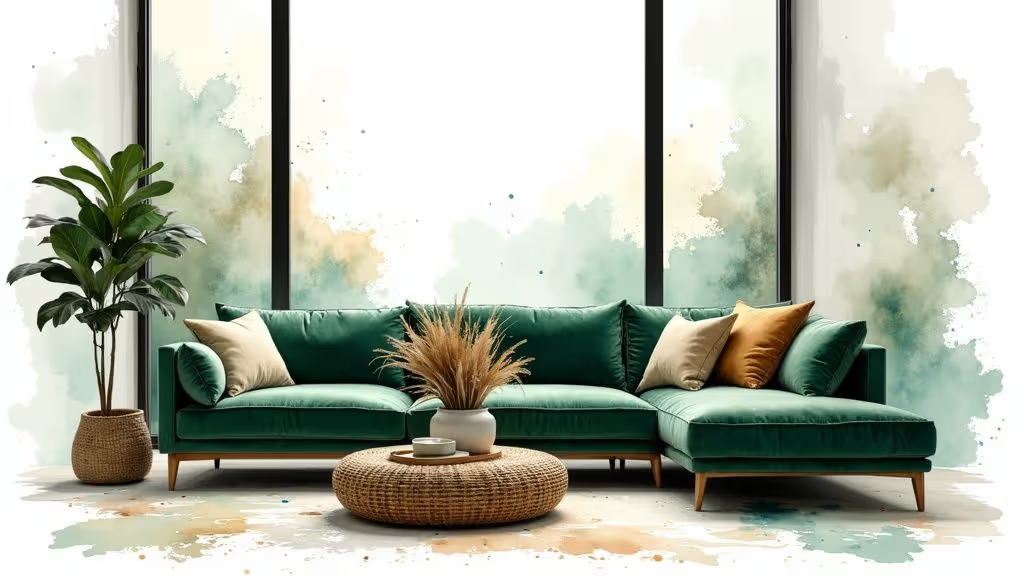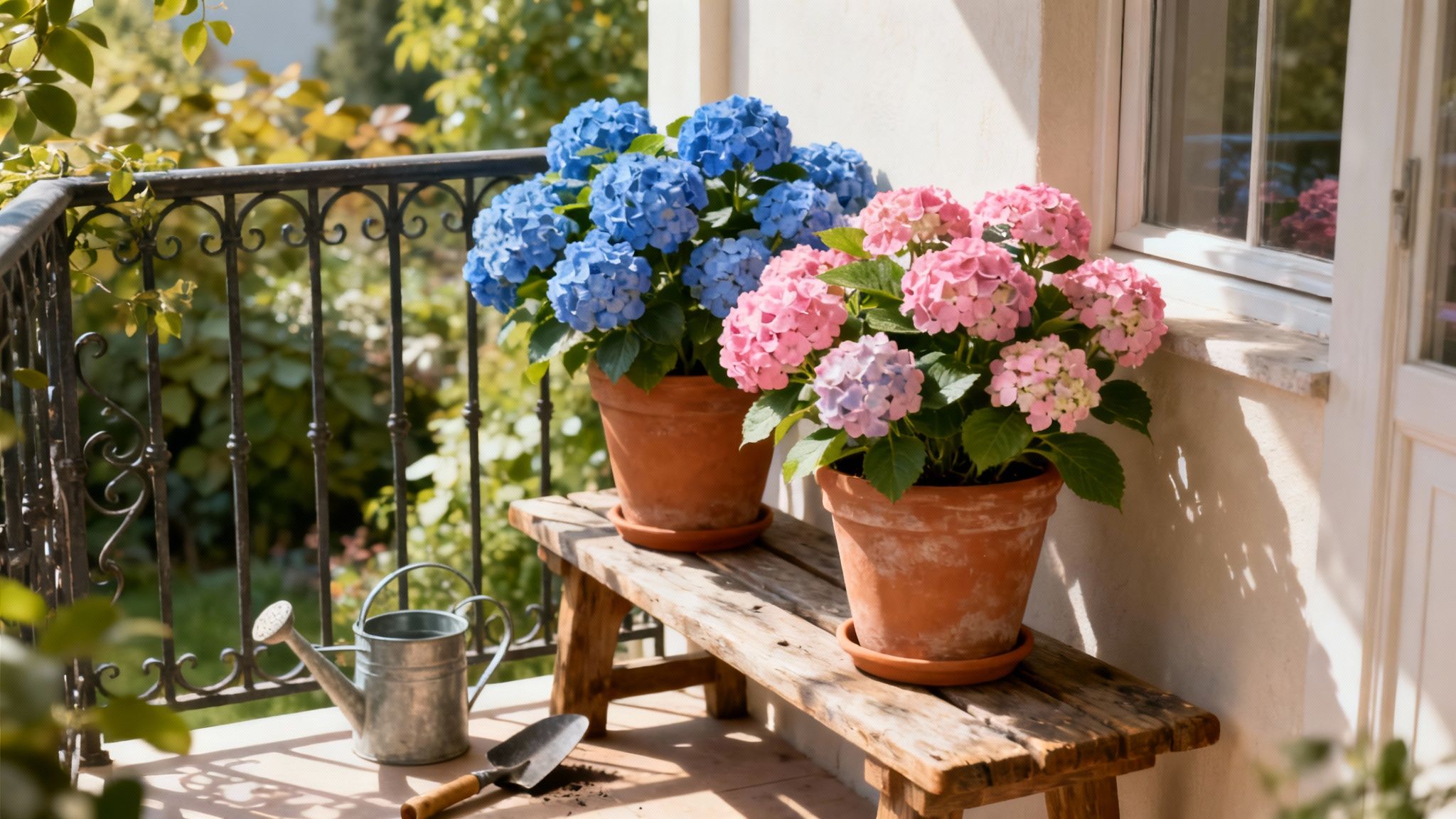Embark on a journey to transform the heart of your home into a sanctuary of style and sustainability. The concept of a 'green living room' has evolved far beyond a simple colour choice; it is a holistic approach to creating a space that is not only visually stunning but also kinder to the planet and beneficial for your wellbeing. This guide explores ten sophisticated and actionable green living room ideas that blend eco-conscious principles with impeccable design.
From integrating the calming presence of nature through biophilic design to choosing furniture with a story, each idea offers a unique pathway to a more thoughtful home. Forget generic advice; we are delving into specific, practical strategies complete with colour palettes, material suggestions, and styling tips. These insights will empower you to create a living space that truly reflects your values.
Whether you're planning a complete overhaul or seeking simple updates, these concepts will inspire a fresher, more vibrant way of living. We will cover everything from non-toxic paints and natural textiles to smart home systems and upcycled décor. Let's cultivate a space that is not just green in colour, but truly green in spirit, creating a healthier environment for you and your family.
1. Biophilic Design Integration
Biophilic design is more than just adding a few houseplants; it’s a philosophy centred on connecting humans with nature within the built environment. Popularised by biologist E.O. Wilson, this approach uses natural materials, light, patterns, and living organisms to create spaces that improve well-being and reduce stress. Integrating these elements is one of the most impactful green living room ideas, as it fosters a serene, restorative atmosphere that feels both organic and deeply calming.
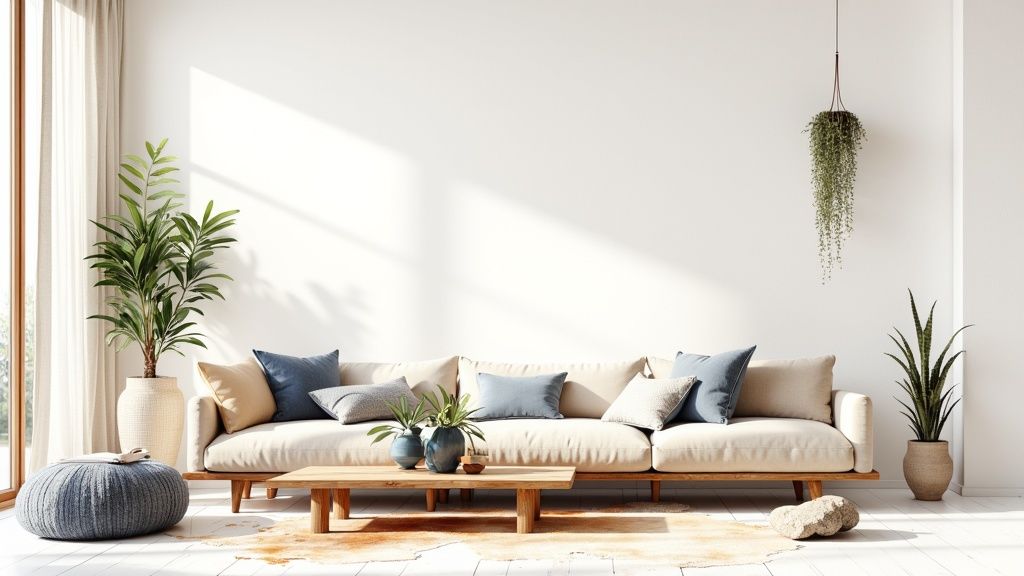
This method directly addresses our innate need to be close to nature, which is why spaces like the Amazon Spheres in Seattle feel so revolutionary. In a residential setting, it translates into a living room that not only looks green but also enhances mental clarity and air quality.
How to Implement Biophilic Design
To bring this concept to life, focus on layering natural elements. Start by maximising daylight with sheer, lightweight curtains instead of heavy drapes. Introduce a variety of low-maintenance plants such as snake plants, pothos, or ZZ plants to create visual interest and purify the air.
- Materials: Choose furniture made from natural wood, such as oak or ash, and incorporate accents of stone, slate, or marble for coffee tables and decorative objects.
- Textures: Use textiles made from natural fibres like wool, linen, and cotton for rugs, cushions, and throws. A chunky wool knit or a raw linen cushion adds tactile depth.
- Sounds and Scents: Consider a small indoor water feature for the soothing sound of flowing water or use an essential oil diffuser with earthy scents like pine or sandalwood.
By thoughtfully combining these components, you can transform your space into a true natural sanctuary.
2. Sustainable and Reclaimed Furniture
Choosing sustainable and reclaimed furniture is a powerful way to infuse your living room with character while making an environmentally conscious decision. This approach shifts the focus from mass-produced, disposable items to pieces with history, durability, and a smaller carbon footprint. Opting for furniture made from reclaimed wood, recycled materials, or certified sustainable sources is a cornerstone of creating authentic green living room ideas, as it champions quality and mindful consumption.
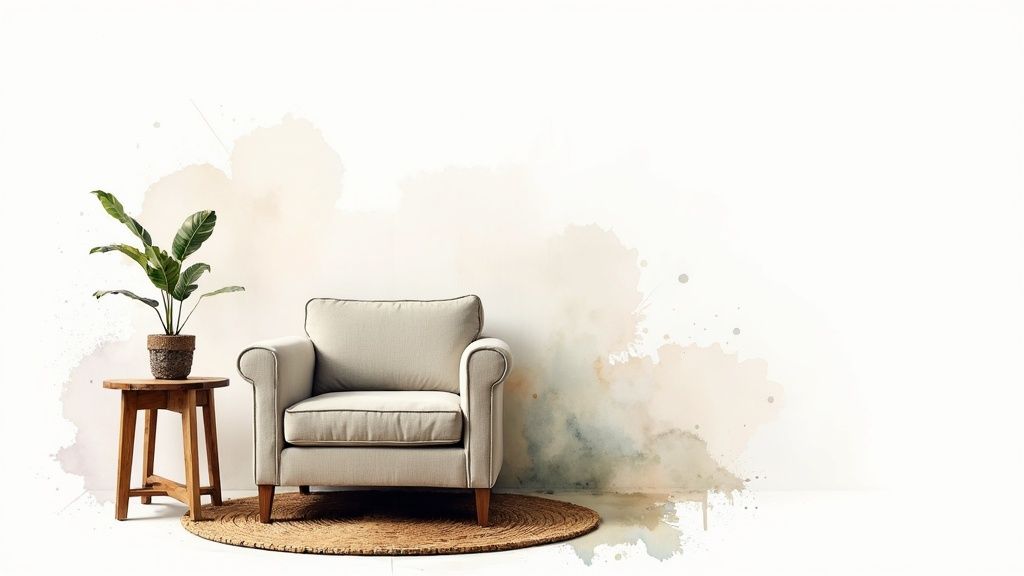
This method not only diverts waste from landfills but also brings a unique narrative into your home. Each knot and grain in a reclaimed wood coffee table tells a story, adding a layer of depth that new items often lack. Brands like West Elm have popularised this by offering stylish reclaimed wood collections, making sustainable choices more accessible than ever.
How to Implement Sustainable Furniture
Begin by exploring local antique shops, flea markets, and estate sales for well-made vintage pieces that can be restored or used as is. When buying new, look for furniture made from rapidly renewable materials like bamboo or search for official certifications to ensure responsible sourcing. Integrating these pieces can be both stylish and affordable; discover budget-friendly home swaps that make a big impact to learn more.
- Certification: Prioritise new wooden furniture with an FSC (Forest Stewardship Council) certification, which guarantees the wood comes from a responsibly managed forest.
- Local Artisans: Commission a local craftsperson to create a custom piece from reclaimed materials. This supports small businesses and results in a truly one-of-a-kind item.
- Mix and Match: Blend a vintage armchair with a new, sustainably sourced sofa. This creates a curated, eclectic look that feels both personal and intentional.
By carefully selecting your furniture, you can design a living room that is not only beautiful but also a testament to thoughtful, sustainable living.
3. Energy-Efficient LED Lighting Systems
Lighting is a fundamental component of interior design, and switching to energy-efficient LED systems is one of the most practical and impactful green living room ideas. LEDs (Light Emitting Diodes) consume up to 75% less energy and last significantly longer than traditional incandescent bulbs, drastically reducing your home's electricity consumption and carbon footprint. Beyond efficiency, modern LED systems offer unparalleled control over your living room's atmosphere, with customisable brightness and colour temperatures.
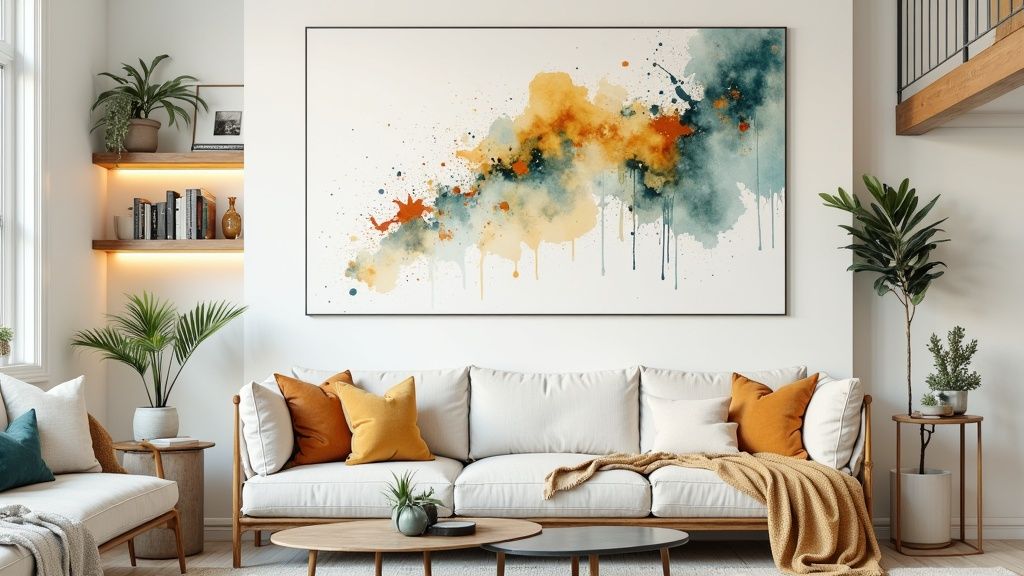
This technological advancement, popularised by pioneers like Philips and championed by efficiency standards such as the ENERGY STAR programme, allows you to create a sustainable home without compromising on style. Smart systems can even mimic natural daylight patterns, promoting a healthier circadian rhythm and enhancing the room’s overall feel from morning to night.
How to Implement LED Lighting
Integrating a full LED system can be done incrementally to manage costs. Start by replacing the bulbs in your main fixtures, such as ceiling lights and floor lamps, before moving on to accent lighting. Smart lighting ecosystems like Philips Hue offer an accessible entry point.
- Choose the Right Temperature: Opt for warm white LEDs (around 2700K to 3000K) to create a cosy, inviting ambiance perfect for relaxing in the evenings.
- Install Dimmers: Add dimmer switches to your main light sources. This provides flexibility to adjust the brightness for different activities, from bright light for reading to a soft glow for watching films.
- Layer Your Lighting: Use a combination of ambient (main ceiling light), task (reading lamps), and accent (spotlights on artwork) lighting. This ensures the room is well-lit and eliminates dark corners, making the space feel larger and more welcoming.
- Automate with Sensors: Consider daylight sensors that automatically adjust your lights based on the amount of natural light available, further maximising energy savings.
4. Living Plant Walls and Vertical Gardens
Living plant walls transform a standard wall into a vibrant, breathing ecosystem, acting as a stunning visual focal point. Popularised by botanist Patrick Blanc, these vertical gardens are one of the most ambitious green living room ideas, ranging from simple mounted planters to complex hydroponic systems. They serve as living art, purify the air by filtering out pollutants, and introduce a powerful sense of nature into the home.
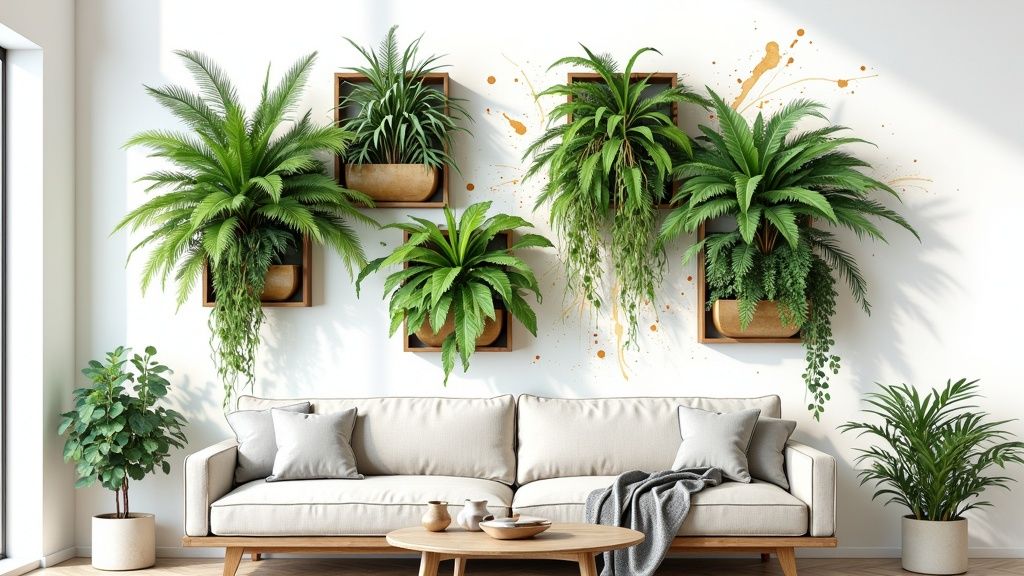
Installations in high-end hotel lobbies and by specialists like Sage Vertical Gardens showcase their dramatic potential. In a living room, a vertical garden brings an unparalleled connection to nature, improving humidity levels and dampening sound for a quieter, more serene atmosphere. To explore similar innovations, discover the latest in garden trends for 2025.
How to Implement a Living Plant Wall
For a successful installation, careful planning is key. Start by assessing your wall's light exposure and structural integrity. A DIY approach can work for smaller, modular systems, but large-scale or automated walls often benefit from professional installation to ensure proper irrigation and waterproofing.
- Plant Selection: Choose species with similar light, water, and humidity needs. Mix trailing plants like golden pothos with upright ferns or peace lilies for varied texture and depth.
- System Type: Select a system that fits your budget and maintenance capacity, from simple soil-based pockets to automated hydroponic panels.
- Waterproofing: Ensure a robust waterproof barrier is installed behind the system to protect your wall from moisture damage.
- Maintenance: Regularly check for pests, prune dead leaves, and ensure the irrigation system is functioning correctly to keep your living wall thriving.
5. Natural Fiber Textiles and Organic Fabrics
Choosing textiles made from sustainably grown natural fibres is a fundamental step in creating authentic green living room ideas. Materials like organic cotton, hemp, linen, and wool are cultivated without harmful pesticides and processed without harsh chemicals, contributing to a healthier indoor environment. This approach supports sustainable agriculture and results in textiles that feel wonderfully soft, breathable, and luxurious against the skin.
Pioneering brands like Coyuchi and Eileen Fisher have brought these conscious choices into the mainstream, showing that style and sustainability can coexist beautifully. By opting for organic fabrics, you introduce a layer of comfort and tactile richness into your living room that synthetic materials simply cannot replicate, all while making a positive environmental impact.
How to Implement Natural and Organic Textiles
Integrating natural textiles is about creating a layered, sensory experience. Start by swapping out old cushions and throws for versions made from organic cotton or a soft wool blend. A beautifully woven linen curtain can diffuse natural light, creating a gentle glow, while a chunky hemp rug adds texture underfoot and grounds the space.
- Certifications: Look for labels like GOTS (Global Organic Textile Standard) or OEKO-TEX to ensure the fabric meets strict environmental and social standards.
- Textures: Combine different natural weaves for depth. Pair a smooth linen sofa cover with a coarse, hand-woven wool throw and nubby organic cotton cushions. You can discover a range of natural linen bedding and textiles that work beautifully in a living room setting.
- Durability: Invest in high-quality, well-made pieces. Natural fibres like wool and linen are incredibly durable and will outlast their synthetic counterparts, reducing waste over time.
- Artisan Support: Seek out local artisans who create hand-woven textiles. This supports small-scale, traditional craftsmanship and adds a unique, story-rich element to your décor.
6. Non-Toxic Paint and Wall Finishes
Choosing non-toxic paint and wall finishes is a fundamental step in creating a truly green living room. Standard paints can release volatile organic compounds (VOCs) into the air for years, negatively impacting indoor air quality and health. Opting for low-VOC or zero-VOC alternatives ensures your walls provide a beautiful backdrop without compromising the well-being of your household, making it one of the most vital green living room ideas.
This approach moves beyond aesthetics to prioritise the health of your home's ecosystem. Brands like Farrow & Ball and Benjamin Moore, with its Natura line, have popularised eco-friendly formulations that are both durable and stylish. These products use water-based formulas and natural ingredients to deliver rich, lasting colour without the harmful off-gassing.
How to Implement Non-Toxic Finishes
To select the right products, look for transparency in ingredients and recognised certifications. Many modern brands offer extensive palettes, so you don’t have to sacrifice style for safety.
- Certifications: Seek out paints with certifications like Green Seal or GREENGUARD Gold, which guarantee low chemical emissions.
- Finishes: Consider natural plasters made from clay or lime for a unique, breathable wall finish. These materials offer rich texture and can help regulate humidity.
- Application: Even with non-toxic products, ensure good ventilation during and after painting to help with the drying process. Always test a sample patch, as colours can appear different under your room’s specific lighting conditions.
By carefully selecting your wall treatments, you create a healthier foundation for your entire living space.
7. Smart Home Automation for Energy Efficiency
A truly green living room goes beyond aesthetics; it operates efficiently to minimise its environmental footprint. Smart home automation is a powerful tool for achieving this, offering intelligent control over lighting, temperature, and electronics. These integrated systems learn your household’s usage patterns and automatically adjust settings to reduce energy waste, all while maintaining optimal comfort and convenience. This is one of the most forward-thinking green living room ideas, as it leverages technology to create a more sustainable and responsive living space.
This approach, popularised by ecosystems like Google Nest and Amazon Alexa, transforms your living room from a passive space into an active participant in energy conservation. It’s about creating a home that is not only smart but also responsible, seamlessly reducing your carbon footprint without requiring constant manual effort.
How to Implement Smart Home Automation
Begin with high-impact devices and expand your system over time. A smart thermostat is an excellent starting point, offering immediate savings by optimising your heating and cooling schedules. From there, you can integrate smart lighting and automated blinds for a more holistic approach.
- Lighting and Shading: Install smart bulbs and switches, such as those from Lutron Caseta, to schedule lighting or dim it remotely. Pair them with automated blinds that close during the hottest part of the day to reduce reliance on air conditioning.
- Energy Monitoring: Utilise systems that provide detailed energy usage reports. This data helps you identify which appliances are consuming the most power, allowing you to make informed changes to your habits.
- Integrated Ecosystems: Choose products that work together within a single ecosystem like Google Home or Apple HomeKit. This ensures seamless communication between devices, enabling you to create automated “routines,” such as an “Away” mode that turns off all non-essential lights and lowers the thermostat when you leave.
8. Upcycled and DIY Decor Projects
Upcycling involves transforming discarded or old materials into beautiful, functional decor, offering one of the most creative green living room ideas available. This approach champions sustainability by diverting waste from landfills and reducing the demand for new products. It’s a powerful way to inject personality and unique character into your living room, creating one-of-a-kind pieces that tell a story and reflect your environmental values.
Inspired by the ingenuity seen on platforms like Pinterest and shows such as 'Salvage Hunters', DIY decor allows for complete creative control. You can design pieces that perfectly match your aesthetic, whether it’s refinishing a vintage sideboard with a bold new colour or turning old wooden crates into a rustic, modular shelving unit.
How to Implement Upcycled and DIY Decor
Start small to build your confidence. Simple projects like painting old picture frames, reupholstering a dining chair seat for use as an accent chair, or creating a planter from a tin can are excellent entry points. Look for free materials on Facebook Marketplace or at local car boot sales.
- Furniture: Give a tired chest of drawers a new lease of life with chalk paint and new handles. An old ladder can be repurposed as a stylish leaning shelf for blankets or books.
- Lighting: Create a unique lampshade by covering an old frame with vintage fabric or construct a pendant light from a collection of glass jars.
- Accessories: Turn wine corks into a noticeboard, old jam jars into candle holders, or broken crockery into a mosaic tabletop for a small side table.
By embracing DIY, you not only craft a greener home but also develop new skills and a deeper connection to the items you own.
9. Natural Air Purification Systems
A truly green living room goes beyond aesthetics to foster a genuinely healthy environment. Natural air purification systems are a cornerstone of this philosophy, focusing on improving indoor air quality by removing toxins and pollutants. This comprehensive approach combines the power of specific plants, strategic ventilation, and modern technology to create a space where you can breathe easier and feel more revitalised.
Pioneering research, such as NASA's Clean Air Study, revealed that common houseplants can effectively filter out volatile organic compounds (VOCs) like benzene and formaldehyde. Integrating these natural purifiers is one of the most functional green living room ideas, as it directly enhances your family's health while adding lush, vibrant life to your décor.
How to Implement Natural Air Purification
Start by layering your purification strategies. Introduce a variety of scientifically-backed plants and support their efforts with mindful habits and technology. This creates a multi-faceted system that keeps your indoor air fresh and clean.
- Plants: Use NASA-recommended plants like snake plants, spider plants, and peace lilies. Group several together to maximise their air-cleaning impact and place them near potential pollution sources, such as new furniture or electronics.
- Ventilation: Make a habit of opening your windows for at least 15 minutes each day to allow fresh air to circulate and flush out stale, polluted indoor air.
- Filtration and Products: Combine botanical efforts with a high-quality HEPA air purifier to capture finer particles. Avoid synthetic air fresheners and harsh cleaning chemicals, which introduce more toxins into your home.
By adopting these methods, you create a living room that not only looks beautifully green but also actively contributes to your well-being.
10. Sustainable Flooring Solutions
The foundation of any room, flooring, presents a significant opportunity to incorporate green living room ideas from the ground up. Sustainable flooring solutions prioritise environmentally responsible materials like bamboo, cork, reclaimed wood, and recycled carpet tiles. These options minimise environmental impact by using rapidly renewable resources or diverting waste from landfills, all while offering exceptional durability and timeless beauty.
This approach proves that eco-conscious choices do not require compromising on style or performance. Brands like Interface Inc., with their carbon-negative carpet tiles, and Cali Bamboo, which specialises in durable bamboo flooring, demonstrate how these materials can anchor a sophisticated and sustainable living space. Choosing sustainable flooring reduces your home’s carbon footprint and often contributes to healthier indoor air quality.
How to Implement Sustainable Flooring
Selecting the right sustainable floor requires balancing aesthetics with practical considerations. Reclaimed wood adds unmatched character and history, while bamboo offers a sleek, modern look. Cork provides excellent thermal and acoustic insulation, making the room quieter and warmer underfoot.
- Research: Look for certifications like the Forest Stewardship Council (FSC) for wood and bamboo to ensure responsible sourcing.
- Suitability: Consider the room’s humidity and traffic levels. Bamboo is extremely hard-wearing and ideal for high-traffic areas, whereas cork is softer and better suited for lower-impact spaces.
- Samples: Always obtain samples to see how the materials look and feel in your living room’s specific lighting conditions before committing.
- Installation: Budget for professional installation, especially for materials like reclaimed wood or certain types of cork, to ensure a flawless finish and long-term durability.
By carefully choosing your flooring, you create a beautiful and resilient base that aligns with your green living values.
Green Living Room Ideas Comparison Matrix
Cultivating Your Own Green Sanctuary
As we have journeyed through these ten distinct yet interconnected green living room ideas, it has become clear that crafting an eco-conscious space is a deeply personal and incredibly rewarding endeavour. From the living, breathing architecture of a biophilic design to the soulful narrative embedded in reclaimed furniture, the potential to create a home that is both visually stunning and fundamentally good for you and the planet is immense. The path to a sustainable living room is not a prescriptive formula but a creative exploration of what resonates most with your lifestyle and values.
The key takeaway is that impactful change doesn’t require an immediate, overwhelming overhaul. Instead, it is built through a series of thoughtful, deliberate choices. By embracing even one or two of these concepts, you initiate a powerful ripple effect. Your journey might begin with the simple, satisfying act of repainting a feature wall with non-toxic, VOC-free paint, or perhaps it starts by introducing a collection of air-purifying plants to your shelves. Each small step, whether it's switching to natural fibre textiles or investing in energy-efficient LED lighting, contributes to a larger, more meaningful transformation.
Weaving It All Together: Your Actionable Plan
To truly bring these green living room ideas to life, consider this your roadmap. Start by evaluating your current space against the principles we've discussed. Which areas offer the greatest opportunity for improvement?
- For the Aesthetically-Minded: Begin with visual elements. Could you swap out synthetic cushions for organic cotton or linen alternatives? Does a statement piece of upcycled furniture or a sustainably sourced rug appeal to you? These changes offer immediate visual and tactile rewards.
- For the Health-Conscious: Prioritise elements that directly impact your indoor environment. Focus on non-toxic wall finishes and introducing a living plant wall or a selection of potent air-purifying plants like Snake Plants and Peace Lilies. Integrating natural air purifiers can noticeably improve the quality of the air you breathe every day.
- For the Tech-Savvy and Practical: Look towards efficiency. Implementing smart home automation to control your lighting and heating, or upgrading to sustainable flooring, provides long-term benefits in energy savings and durability. These are investments that pay dividends for years to come.
Ultimately, designing a green living room is about more than just following trends; it is about cultivating a personal sanctuary. It’s about building a space that nurtures your well-being, reflects your commitment to sustainability, and inspires a deeper connection to the natural world. By consciously selecting materials, embracing nature, and prioritising efficiency, you are not just decorating a room. You are mindfully crafting a healthier, more harmonious, and genuinely inspiring home for the future.

